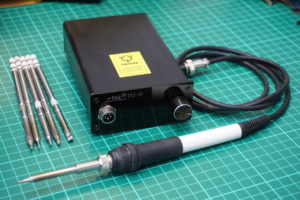 I have used a variety of different soldering irons over the years. I started with a simple, fixed temperature iron during my childhood days to burn wholes in my mom’s carpet and came across different soldering iron brands the last years. I used them for heavy duty stuff such as soldering Li-Ion cells, delicate fine pitched SMD stuff, accidentally burning holes in furniture, and of course testing the temperature resistance of my skin.
I have used a variety of different soldering irons over the years. I started with a simple, fixed temperature iron during my childhood days to burn wholes in my mom’s carpet and came across different soldering iron brands the last years. I used them for heavy duty stuff such as soldering Li-Ion cells, delicate fine pitched SMD stuff, accidentally burning holes in furniture, and of course testing the temperature resistance of my skin.
Some years ago I was annoyed by the different cheap irons I had used and bought a digital Ersa RDS 80W. It did what it was supposed to do and with the proper (thick) tips I was able to get good and fast heat transfer to Li-Ion cells as well. I was always a bit disappointed by the performance with small tips. So I got used to use the 4mm tip for fine pitch SMD assembly.
I often see people giving the advice to ramp up the temperature to 475°C or more in order to solder heavy duty wires or multilayer PDBs. NO, DO NOT DO THIS! This will probably melt connectors or destroy the PCB. My advice in the past was to use bigger tips for better heat transfer.
When we got the JBC soldering irons at work I was stunned. Their special feature is that they have the heating element plus sensor directly in the front of the tip. They heat up (almost) instantaneously and the heat transfer is incredible. You can use the finest tip to desolder wired components from a multilayer PCB. Thanks to the special tip construction the soldering station measures the temperature exactly where you solder and can keep up the temperature at the right level.
It was clear that I needed to have that at home as well. Well… Check the price point of those JBC stations. No way that I can justify spending the whole holiday money on such a (useless) toy. So I started to look for alternatives. And I found it! Hakko sells soldering irons using the “T12” tip system. Those tips are similar to the ones found on JBC, direct measurement and powerful heating directly at the tip.
It’s getting even better: As such a soldering station is not that complicated to build, all you need is a sensor, a heating element and some kind of PID controller to regulate the temperature, there are some cheap stm32 based soldering controllers you can buy in china. They come with a T12 compatible soldering tip holder and when I say cheap, I really mean cheap: The whole set of my OLED soldering controller was $52 + import tax. About one third of what I paid for my old Ersa station… If you do not need the fancy OLED screen you can go even cheaper, a similar LED version sells for $42 on banggood. And the best thing: T12 soldering tips come in all shapes and sizes and are dirt cheap as well ($2-4)!
So I jumped in and bought a OLED T12-D soldering station from aliexpress, it came with the tip holder and one soldering tip of my choice:
In addition I bought the following soldering tips:
From left to right: T12-BC1, T12-D24, T12-D16 (new), T12-D16 (used), T12-WD52, T12-ILS.
You might be asking why do you need that many? Well, I had no idea on how well they perform so I ordered a whole set:
- T12-ILS: for heavy duty stuff, soldering multiplayer PDBs or Li-Ion cell tabs
- T12-D24: cabling, e.g. soldering XT60 connectors
- T12-D16: good multi use tool, I use it for fine pitch SMD and cabling works
- T12-BC1: very fine pitched SMD stuff
The station comes in a nice aluminum extruded case and the cable to the tip is very flexible. But be careful, the station is sold with different kinds of tip holders, not all might feature this flexible cable. Let’s have a look at the user interface:
The station comes with a nice and bright graphical OLED screen. The right knob is a encoder with a pushbutton, you can rotate it 360° and use the button to click. The interface is quite simple, use the knob to set the target temperature (shown in the upper left corner) and there you go. You can see the case temperature (upper right corner), the power supply voltage (lower left), the supply voltage (lower left), and the lower right shows the current power consumption. The big center letters show the current tip temperature. A long button press enters a menu where you can set some default values. The station comes with a neat tip saving feature: There is a motion sensor inside the handle and after some time of no use the station will power down to a predefined storage/idle temperature. Once you pick up the handle it powers up again and you are at soldering temperature within some seconds — really neat!
Wait, that sounds to good to be true, right? Where is the catch? As you can see I used the station the last months a lot. Everything was fine… I was using the power cable from my laptop charger to power the station, it used the same mini 3-pin AC connector (ground, live and protective conductor):
I was blown away by the performance. I used the D16 tip the most, from fine pitched stuff to heavy duty stuff. Quick heat up within seconds, no problems with multilayer PDBs and perfect temperature control. You can even swap the tips while they are hot! The lower end that inserts into the hand tool stays cool enough to be swapped by hand — amazing! But then we moved to a new apartment…
I was soldering the tinyPEPPER2S esc end got some bad FETs. I swapped them and all was fine. I was wondering how I damaged them, I took ESD precautions and there was no static electricity around — at least I though so.
When working on my tinyOSD prototype the last days I had some strange issues with the stm32, some analog circuits did not behave as it should after some soldering rework. Then, while soldering again, I was shocked, with nothing connected to the circuit, the red status led started to light up once I touched the PCB with the soldering iron! — what the heck?!
I took my multimeter and got surprised by a (high impedance) 130V AC voltage on the soldering tip — wait, this should be grounded via the protective conductor, right?
I checked everything inside the soldering controller. Looks good, a stable connection from protective ground to the tip (0.6Ohm). Then I realized that I had swapped the power cable during the move. I took it apart and what I saw was really shocking:
So this is a three (!) pole mains cable: Neutral, Phase, and Protective ground — Do you spot the failure?
Beside from the minimal wire gauge of 0.2mm² or less, which is supposed to be 1.5mm², there are only two conductors! They saved some bucks by optimizing the third “unnecessary” cable away. I was shocked… I did not expect this to happen. You might say you get what you pay for — and you might be right. But I can not see why one should sell stuff with those dangerously “optimized” cables when the rest of the station is really really nice.
So would I buy it again? Yes, definitely! This is the best soldering station I have been working with at home. It outperforms by Ersa station a hundred times. Sure, the JBC at work is a bit better but it costs more than ten times what I paid for this. Just make sure to check the mains cable and in case the shield is missing make sure to ditch it and buy a proper cable!
And now enjoy hassle free soldering!

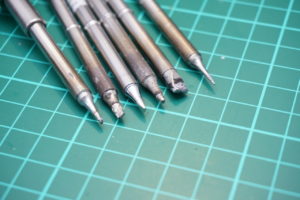
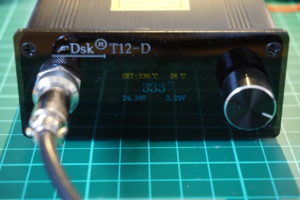
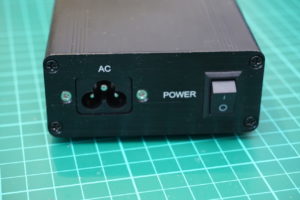
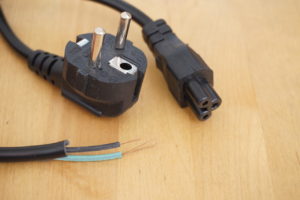
Do you know if the firmware is upgrade-able/hack-able and where to download the latest version?
Is this soldering station still working well for you? I’m thinking of getting a similar model for various projects.
Yes, I am still loving it!
Thanks Fishpepper, you always bring interesting topics at the table!
Indeed we are soldering a lot in this hobby, why not spend a few bucks on a better iron. Although my Solomon station doing a pretty decent job, I couldn’t resist ordering a T12 station too. 72 watt controlled heating power direct in the tip! I went for the Quicko O-led version, but probably all those brands moreless the same.
The Aliexpress Quicko store also offers different type of T12 TIP Quality, any one experiences with the more expensive T12 tips? I ordered those, instead of the cheaper ones (3usd for a tip or sets of 10 different tips for 20usd, that can’t be right, too good to be true……?)
My experiences a good tip can last for years and years a bad tip can self destruct or just vaporize pretty quickly……
So far I do not have any issues at all with the tips itself. The coating/material looks fine on all of them, no matter how much I paid (I always bought them cheap on ali).
However, I have one out of 12 (?) tips where the white insulator on the other end got crushed and felt apart. Might have been shipping damage, who knows.
Hello, is this the WD52 tip? What experience do you have with it? Ciao!
The biggest one in the pictures show the WD52 tip. It works really good for XT60 soldering etc.
Does anyone know if the T13 tip is same / similar to the T12?
I see an amazing deal for a T13 solder on amazon at https://www.amazon.com/Soldering-110to240V-Including-Portable-Temperature/dp/B074V28ZVS
but.. not sure if it is the same architecture
I have never used T13 before. It seems like it is superseded by the T17 series ?!
yeah looks like older model.. maybe i will just have to build a t12 – saw some tutorials on youtube.
I just bought the Aoyue 469 soldering station before reading your posting (https://www.amazon.com/Aoyue-Variable-Soldering-Station-Removable/dp/B00MCVCHJM)
It wasn’t as good as what i thought it should be. the t12 sounds like a better solution from your description. thanks for the blog.
I guess your model come with an AC-DC transformer. From the description of some similar kit on banggood, it seems you just need to feed the controller board with something between 12 and 24V. Did you consider to make a portable version with a XT-60 connector. It should work fine with a 4S or 5S LiPo, no?
You can buy the controller board without the case and AC transformer e.g. here.
Should be no big deal to build a portable station. The T12 tip holder is quite small, would be nice for in field repair! Good idea 🙂
Here is a portable version (I have my notebook adapter with 24V/3A already)
https://de.aliexpress.com/item/MINI-T12-OLED-l-tstation-elektronische-schwei-en-eisen-2017-Neue-design-DC-Version-Portable-T12/32839523934.html
Did you notice that under the Ayima brand, they’re offering all the parts of the station separately?
aliexpress
You can get the control board for US$18.80; great for a DIY custom workstation or for those who have a toasted older station with a good power supply and just want to upgrade the electronics.
Cheers,
mnem
Oh, for ifni’s sake… they have kits for ~US$10 for just the board up to ~US$20 for a complete kit with handle and a tip
based on the LED and version of this controller board all over fleaBay now. You How did I NOT know about this?!?
I have an old Aoyue 2702 Hot Air Rework/Soldering/Desoldering station based on the T12 clone architecture… an awesome soldering station, but the compressor wore out and died twice in a few years and I gave up on it. I am quite tempted to get the OLED controller board and chunk the big old 2702 box that has been wasting space on my bench for years…
Oh, BTW… thanks for your hard work on the fishpepper FC/ESCs… they’re awesome. 😀
I know 🙂 But the whole station with soldering tip holder, case, and powersuply looks like the better deal to me if you do not have an old station you might want to convert 🙂
Hi Simon,
I have read you article and I was quite surprised you did ‘t mention Weller products ;)) Did you have any experience with those? I’ve built DIY version of WMRP soldering station a while back and I have to admit it works really well with original Weller RT series tips.
Also not sure about buying a knockoff soldering tips from banggood or aliexpress for T12 type soldering station.
I havent used those but previously I was using cheap hakko tips (not T12) from BG (knockoff) and the tips were getting dirty and unusable really quickly 🙁 Can you share your thought on the quality of those T12 tips too?
I have used the old Weller stations. I have no experience with the newer ones. But I was so disappointed by my Ersa that I started to look for alternatives 😉
The T12 tips I got from ali and banggood are fine. Some look like after sale market parts but work as intended to. No failures for the last 6 months. Some look genuine with Hakko laser markings on the tips, not sure if they are fakes or not.
Great post. Thanks for sharing. And perfect timing as I am in the market for a new iron 🙂 Was considering some basic Hakko but this one looks much more interesting and is much cheaper as well.
I noticed in the description that the iron has an auto sleep function. Does the unit also have auto wake-up using a sensor in the handle? I noticed a review of a similar product on youtube and apparently it had the auto wake up built int.
One more thing, is the cable quite soft and flexible or is it rather stiff as found on most cheaper soldering irons?
Many thanks.
I just updated the description 😉 Auto sleep works quite well and my cable is very flexible. Probably silicon.